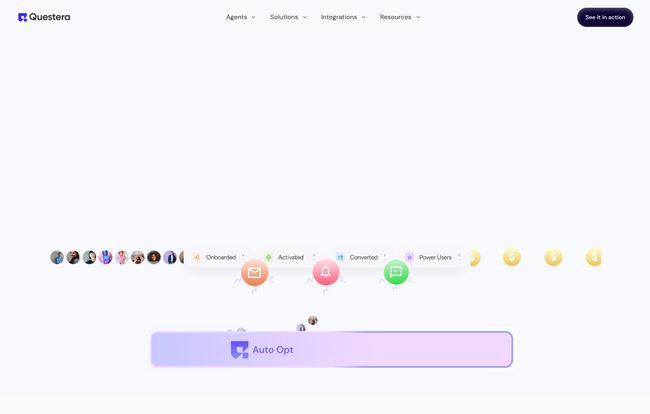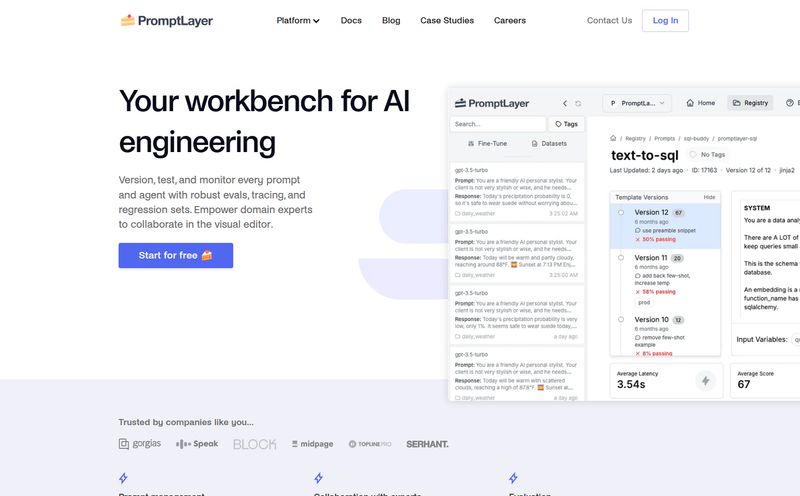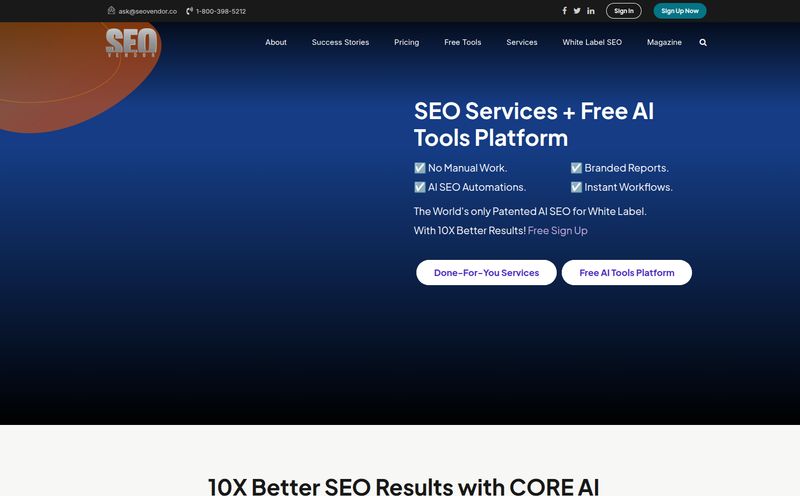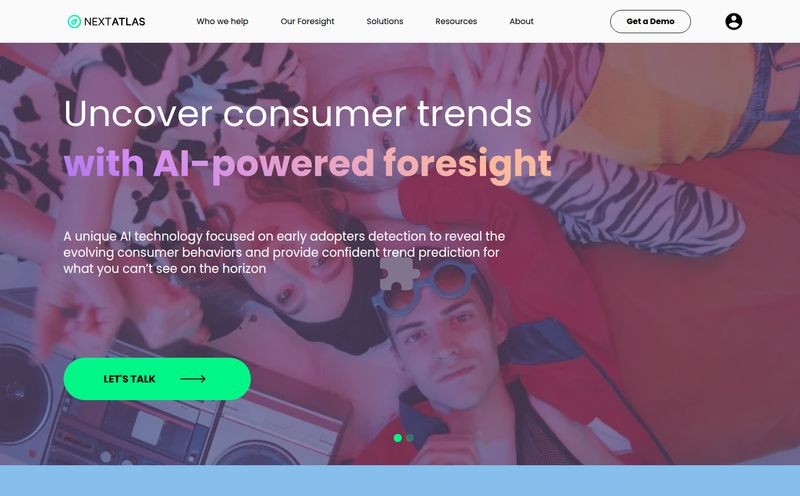As a marketing pro, how many times have you heard the word "personalization" this week? Ten? Twenty? It’s become the ultimate buzzword, slapped onto every SaaS platform imaginable. Yet, for all the talk, most of what we get is glorified mail merge. `[First_Name]`, here’s a 10% discount on the thing you looked at last week. Groundbreaking, right?
I’ve been in the trenches of SEO, CPC, and traffic gen for years, and I’ve become a bit of a cynic. We have more data than we know what to do with, but connecting it all to create a genuinely... human experience for the customer feels like trying to build a spaceship with duct tape and hope. It’s messy. It’s disconnected.
So, when I came across Questera and their pitch about an "Agentic Customer Engagement Platform," my curiosity was piqued. Agentic AI? It sounds like something out of science fiction. The idea isn't just about automating tasks; it’s about creating a team of specialized AIs—agents—that think, reason, and act to manage the entire customer journey. A pretty bold claim. So I decided to take a look.
So, What is Questera, Really?
Forget the jargon for a moment. At its heart, Questera is trying to solve the disconnection problem. It’s a platform designed to let you build and deploy a team of AI agents that handle different parts of customer engagement. Think of it less like a single tool and more like a central nervous system for your marketing efforts.

Visit Questera
Instead of you manually building a segment in your ESP, then creating a campaign in your ads manager, then analyzing results in a third tool... Questera aims to have its agents do that collaboratively. It unifies your data from all those disparate sources—your CRM, your analytics, your support tickets—and gives these AI agents the context they need to make smart decisions in real-time. The goal? To move a user from just being a visitor to a loyal, happy customer, almost on autopilot. A lofty goal, but an exciting one.
Meet the AI Agents: Your New Digital Workforce
This is where Questera gets really interesting. It’s not one monolithic AI. It’s a collection of agents, each with a potential specialty. The platform lists a few, like ELMA, GIA, SARA, OMNIA, SEGA, and GRETA. While they don't spell out exactly what each acronym stands for, a marketer's imagination can run wild. Here’s my take on what a team like this could look like:
| Potential AI Agent | My Best Guess at Their Role |
|---|---|
| SARA (Segmentation & Audience Refinement Agent) | The data whiz. SARA probably sifts through mountains of user data to find those perfect, high-intent micro-segments you'd never find on your own. |
| ELMA (Engagement & Lifecycle Messaging Agent) | The communicator. This agent likely crafts and tests different message variants, finding the perfect tone and offer for each segment SARA identifies. |
| GRETA (Growth & Retention Engagement Tactics Agent) | The strategist. GRETA might monitor user behavior for signs of churn and proactively intervene with a special offer or helpful content to keep them around. |
| OMNIA (Omnichannel Orchestration & Navigation AI) | The conductor. This agent ensures the customer experience is consistent, whether they're on your website, seeing a social ad, or opening an email. |
Again, this is just my interpretation, but it illustrates the power of the concept. You're not just automating an email; you're automating the strategy, segmentation, execution, and optimization loop. It's a fundamental shift in thinking.
From Data Chaos to Unified Clarity
One of the biggest headaches for any marketing team is data silos. Your web analytics are in GA4, your sales data is in Salesforce, your ad spend is in Google Ads... getting them to talk to each other is a nightmare. Questera puts a huge emphasis on its data unification and connectivity tools. By plugging everything into one place, the AI agents get a 360-degree view of the customer. This is the foundation that makes true AI-driven segmentation possible. It's not just about demographics; it's about behavior, intent, and history.
The Good, The Bad, and The AI-Powered
No platform is perfect, of course. After digging around, here’s my honest take on the highs and lows.
The Upside: What I Genuinely Liked
The speed is a huge one. The promise of launching campaigns in minutes, not months, is appealing to anyone who's ever been stuck in a development queue. Because the platform is built for marketers (even though its developer-first), the intuitive campaign builder and audience hub mean you don’t need to be a coding genius to get things done. I’ve wrestled with some incredibly clunky martech platforms that felt like they were designed by engineers who'd never actually met a marketer. This feels different.
But for my money, the real magic is the AI-driven personalization at scale. It's the ability to have real-time interventions. Imagine an AI agent noticing a high-value customer's cart abandonment and instantly triggering a personalized push notification with a unique, one-time offer. That’s not just automation; that’s intelligence.
The Reality Check: Potential Hurdles
Okay, let's ground ourselves. This isn't a plug-and-play magic box. The first con is the initial setup. Unifying all your data sources takes work. You have to be prepared to invest some time upfront to get all the pipes connected correctly. Garbage in, garbage out—even for a smart AI.
Secondly, there's a potential learning curve, especially if you want to create custom AI agents. While the platform seems marketer-friendly for its core functions, tapping into its full power might require a bit more technical know-how. And finally, you are placing a lot of trust in the AI models. For control freaks (and what good marketer isn't one?), letting an AI make real-time decisions about budget and messaging can be a little scary at first. It requires a shift in mindset and a trust in the system you've configured.
So, Who Is Questera Actually For?
I don't think this is a tool for the solo blogger or a small mom-and-pop shop just starting out. Given the emphasis on data unification, multiple integrations, and custom agents, Questera feels best suited for mid-market to enterprise-level companies. Specifically, teams that are feeling the pain of their current marketing stack. If you have a dedicated marketing team, a developer or two you can pull in, and you're frustrated by the limitations of disconnected, "dumb" automation tools, then you are the target audience. You're ready to move from just sending campaigns to orchestrating intelligent customer journeys.
Let's Talk Money: The Questera Pricing Mystery
And now for the question on everyone's mind: how much does it cost? Well, if you go to their website, you'll find... no pricing page. This is pretty typical for platforms in this league. Pricing is almost certainly custom and based on factors like the volume of contacts, the number of data sources you connect, and which AI agents you deploy.
Don't see this as a red flag. It’s a sign that they're not selling a one-size-fits-all product. The best path forward here is the classic one: reach out and book a demo. That's the only way to get a real sense of what it would cost for your specific needs.
Frequently Asked Questions About Questera
1. What kind of platforms can Questera integrate with?
Based on their materials, Questera is built for connectivity. It mentions integrations with common sources like Google Analytics, Google Ads, Mixpanel, and Braze. The whole premise relies on pulling data from your existing stack (CRMs, analytics tools, ad platforms, etc.) and then pushing actions out to various destinations.
2. How does Questera actually save businesses money?
The main cost savings would likely come from two areas. First, efficiency: automating complex campaigns and analysis saves countless hours for your marketing team. Second, effectiveness: by improving personalization and intervening at the perfect moment, the AI agents can increase conversion rates and customer lifetime value, boosting revenue directly.
3. Is Questera suitable for a small business?
Probably not for a very small one. The need for multiple data sources and the potential complexity of setup suggest it’s a better fit for a company that has already scaled to the point where they are experiencing significant challenges with managing their customer engagement across multiple channels.
4. How much technical skill is needed to use Questera?
It seems to be a tale of two platforms. For day-to-day campaign building and audience management, it’s designed to be intuitive for marketers. However, to leverage its full power—like building unique, custom AI agents—you'll likely need some developer resources or a more technical person on your team.
5. Can I trust an AI to manage my customer interactions?
That's the big question, isn't it? It's about setting the right rules and guardrails. You don't just turn it on and walk away. You configure the agents, set the goals, and monitor the performance. It's a partnership between human strategy and AI execution, not a replacement for the marketer.
My Final Thoughts on Questera
So, is agentic AI the future of marketing? I’m starting to think it just might be. We're at a point of diminishing returns with the old way of doing things. Questera is a fascinating glimpse into a new direction. It’s ambitious, for sure, and it’s not for everyone. But for the right company, it could be the key to finally delivering on that overused promise of true, one-to-one personalization at scale.
It represents a move away from being a digital switchboard operator, manually connecting calls, to becoming an architect, designing an intelligent, self-running system. And as a marketer who loves building things that work, that's an incredibly exciting prospect. It’s defintely a platform to watch.
Reference and Sources
- Questera Official Website
- Forbes Article: The Rise Of AI Agents And The Future Of Automation
- MarTech: What is a customer data platform (CDP)? - For context on data unification.



